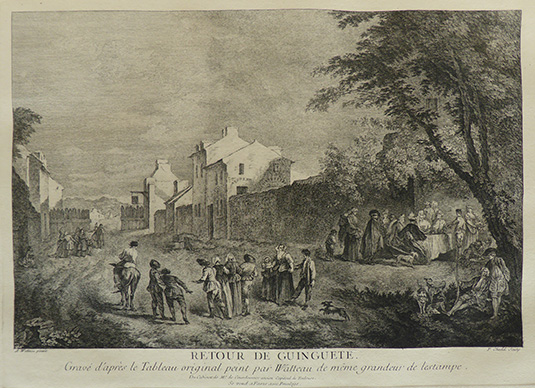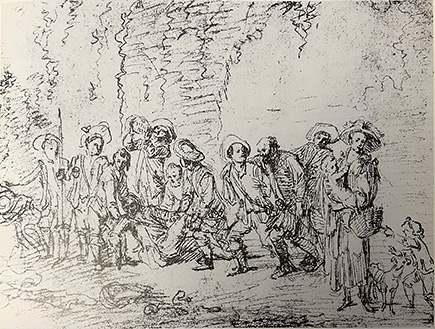
- Home Page
- Accepted
Paintings & Copies - Doubtful
Attributions - Doubtful Textual References
- Alternative
Titles - Collectors &
Museums - Bibliography
- Search Abecedario
- Watteau &
His Circle
Retour de guinguette
Entered May 2022

Presumed lost
Materials unknown
24 x 37 cm
ALTERNATIVE TITLES
Return from the Pleasure Garden
Ritorno dell’osteria
RELATED PRINTS

Quentin Pierre Chedel after Watteau, Le Retour de guinguette, engraving, 1731.
Watteau’s Retour de guinguette was engraved by Quentin Pierre Chedel in the same size as the painting, but probably in reverse. The print was announced for sale in the December 1731 issue of the Mercure, p. 3091.
PROVENANCE
Toulouse, collection of M. Courdoumer (capitoule [magistrate]). His ownership of the painting is indicated on Chedel‘s 1731 engraving: “Du Cabinet de M. Courdoumer, ancien capitoule de Toulouse.”
SELECT BIBLIOGRAPHY
Hédouin, “Watteau” (1845), cat. 51.
Hédouin, Mosaïque (1856), cat. 52.
Goncourt, L’Art au dix-huitième siècle (1860), 58.
Goncourt, Catalogue raisonné (1875), cat. 196.
Dacier, Vuaflart, and Hérold, Jean de Jullienne et les graveurs (1921-29), 3: cat. 154.
Réau, “Watteau” (1928), cat. 169.
Barker, Watteau (1939), 52.
Adhémar, Watteau (1950), cat. 41.
Mathey, Watteau, peintures réapparues (1959), 66.
Macchia and Montagni, L’opera completa di Watteau (1968), cat. 25.
Roland Michel, Watteau (1981), cat. 63.
Roland Michel, Watteau (1984), 116, 300, 305.
Posner, Watteau (1984), 21.
RELATED DRAWINGS

Watteau, Drunken Villagers, red chalk, 16 x 21 cm. Whereabouts unknown.
No Watteau drawings from the model can be directly associated with Retour de guinguette. But Roland Michel astutely observed that a compositional study (Rosenberg and Prat 73), previously identified as a military subject with wounded soldiers being carried off the battlefield (upheld by Parker and Mathey, Grasselli, Rosenberg and Prat, and Wile) should instead be read as a group of drunken peasants, some helping their inebriated companions who cannot stand or move on their own. There are no rifles or other kinds of military equipment; none of the men have bloodied bandages. Rather, a great many of them are in a drunken stupor, unable to support themselves, much less walk. Emphasizing the alcoholic nature of the subject, a man to the left of center continues to drink wine from a bottle. This was the type of drunken scene that Watteau could have witnessed and that fueled the imagery that we see toward the center of Retour de guinguette.
REMARKS
The composition is formed from a series of three distinct vignettes set within an extensive landscape. At the right of the engraving (but presumably at the left in the original painting), two gentlemen-hunters linger under the shade of a tree. In the central foreground, ten villagers return home, in an evidently happy, tipsy condition. Not to be overlooked, farther back at the right a dozen well-dressed people sit around a table and a meal is in progress. A gypsy woman with children approaches them, perhaps asking for charity or, equally possible, offering to tell fortunes. Scenes with gypsy fortune tellers are found in a number of Watteau’s early drawings and, of course, in his painting La Diseuse d'aventure, now in the Sauvage collection.
Although Retour de guinguette has not attracted much critical attention, those scholars who have considered the work agree that it represents an early phase in Watteau’s career and that it was painted under the influence of Dutch and Flemish art of the previous century. Mathey assigned Watteau’s painting to a date c. 1707-08, Montagni and Macchia suggested c. 1708, Roland Michel preferred 1708-10, whereas Barker and Adhémar dated the painting c. 1710. The early date of the composition is affirmed by the fontanges—lace headdresses—worn by several women at the table and also several women in the far distance. The fashion for fontanges waned toward 1715 and thus such accessories appear only in a few of Watteau’s early works, such as his illustrations to the plays of the Corneille brothers and in paintings such as Le Retour de la garnison.
Click here for copies of Retour de guinguette